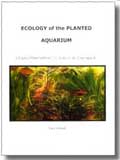Ecology Of The Planted Aquarium
A Practical Manual and Scientific Treatise for the Home Aquarist
by Diana Walstad

I have always had live plants in my aquariums, with mixed success. There are plants that seem to thrive in some aquariums, no matter what, and some that just don’t survive. With my smaller aquariums, with good filtration and reasonable lighting, and a few plants, I have tried to setup a balanced ecosystem that required less frequent maintenance than what is usually suggested. But when I set up my 55-gallon freshwater aquarium — my first big fish tank — I knew that I could set up a more robust ecosystem, due to the larger volume of water.
I had so far tried using the appropriate lighting, gravel, under-gravel heaters and CO2 injection to encourage good plant growth. With my 55-gallon tank, I was beginning to see plants grow healthily. This is when I wanted to try and balance my aquarium in such a way that plants and fish could live and grow well, while I could minimize my disruptive maintenance tasks such as water changes, filter cleaning, algae scrubbing, etc.
I came across this book at Amazon.com, and read a couple of reviews. They seemed to suggest that this book covered various aspects of water chemistry that is critical for a balanced aquarium. I bought the book right away, and it arrived a few days later.
I spent the next week or so poring over the details in the book. This book is very different from an average “how to maintain an aquarium,” or, “how to grow plants in an aquarium” kind of book. It is like a scientific journal that discusses water chemistry in great detail. It describes how plants are water purifiers, chemical interactions between organisms (allelopathy), how the bacteria impact the aquarium, how carbon can actually limit the growth of submerged plants, and how hobbyists can provide more CO2 to their plants. It also highlights the use of good substrates, how to control algae, and what the sources of plant nutrients are.
The book underlines the concept of a ‘Low-Tech’ Aquarium. The author suggests ways to set up one using a moderate number of fish, reduced filtration and cleaning, a large number of healthy plants and diverse microorganisms. She also highlights the attributes of such an aquarium, where the pH remains stable, maintenance required is low, and how the fish behavior is normal.
If you have toyed with the idea of setting up a natural ecosystem in your aquarium where the fish and the plants live and grow healthily, then it is worth reading this book to get some insights. Like I said before, there is a lot of detail in this book, and you may not be able to implement everything that is suggested, but knowing what factors are conducive and what factors are not for setting up such an aquarium will take you a long way in your pursuit.






























[…] Original post by Editor […]